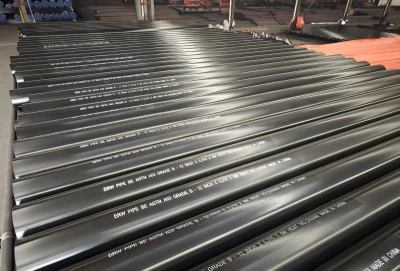ASTM A53 Gr B Pipe and A106 Gr B pipe. These robust steel pipes are the unsung heroes of countless industrial applications, quietly supporting the infrastructure that keeps our modern world running smoothly. But what exactly are they used for, and how do they differ? Let's dive into the fascinating world of industrial piping and uncover the unique characteristics and applications of these essential components.
|
|
|
Industrial Applications of ASTM A53 Gr B and A106 Gr B pipes
When it comes to industrial piping, versatility is key. Both ASTM A53 Gr B and A106 Gr B pipes offer a cornucopia of uses across various sectors. Let's explore some of the most common applications:
1. Construction and Structural Support: ASTM A53 Gr B pipes are often the go-to choice for construction projects. Their sturdy nature makes them ideal for structural support in buildings, bridges, and scaffolding. These pipes can withstand significant loads and provide the necessary strength to keep structures standing tall and proud.
2. Water and Sewage Systems: Both pipe types play a crucial role in our water infrastructure. They're commonly used in municipal water systems, helping to transport clean water to homes and businesses, as well as in sewage systems for waste management.
3. Fire Sprinkler Systems: Safety is paramount in any building, and ASTM A53 Gr B Pipe is often chosen for fire sprinkler systems. Its reliability and resistance to high pressures make it an excellent choice for this critical safety application.
4. Oil and Gas Industry: A106 Gr B pipes are frequently used in the oil and gas sector. Their ability to withstand high temperatures and pressures makes them ideal for transporting petroleum products and natural gas over long distances.
5. Power Generation: In power plants, both pipe types find their niche. A106 Gr B pipes, in particular, are favored for high-temperature steam lines due to their superior heat resistance.
6. Chemical Processing: The chemical industry relies on these pipes for transporting various substances. Their corrosion resistance and durability make them suitable for handling a wide range of chemicals.
7. HVAC Systems: In large commercial and industrial buildings, these pipes are often used in heating, ventilation, and air conditioning systems, helping to maintain comfortable indoor environments.
8. Automotive Industry: The automotive sector uses these pipes in manufacturing processes and for creating specialized parts for vehicles.
9. Agriculture: In agricultural settings, these pipes are used for irrigation systems, helping to distribute water efficiently across large areas of farmland.
10. Mining Operations: The mining industry utilizes these pipes for various applications, including transporting water, slurry, and other materials in and out of mines.
The versatility of ASTM A53 Gr B and A106 Gr B pipes is truly remarkable. From the depths of mines to the heights of skyscrapers, these pipes form the backbone of our industrial infrastructure. Their ability to adapt to different environments and withstand various pressures and temperatures makes them indispensable across a wide spectrum of industries.
Comparing the suitability of ASTM A53 Gr B and A106 Gr B for high-temperature environments
When the heat is on, not all pipes are created equal. The suitability of ASTM A53 Gr B and A106 Gr B pipes for high-temperature environments is a crucial factor in many industrial applications. Let's compare these two types and see how they stack up when things get hot:
1. Temperature Resistance: A106 Gr B pipes take the lead when it comes to high-temperature applications. They're specifically designed to withstand elevated temperatures, making them the preferred choice for environments where the mercury rises. ASTM A53 Gr B pipes, while robust, are generally better suited for moderate temperature ranges.
2. Strength at High Temperatures: A106 Gr B pipes maintain their strength and structural integrity even at high temperatures. This makes them ideal for use in power plants, refineries, and other industries where pipes are exposed to extreme heat. ASTM A53 Gr B Pipe, while strong, may not perform as well under such intense thermal stress.
3. Creep Resistance: Creep, the tendency of a material to deform permanently under stress over time, becomes more pronounced at high temperatures. A106 Gr B pipes exhibit superior creep resistance, maintaining their shape and structural integrity even under prolonged exposure to high temperatures.
4. Thermal Expansion: Both pipe types will expand when heated, but A106 Gr B pipes are engineered to handle this expansion more effectively in high-temperature environments. This property is crucial in preventing leaks and maintaining system integrity under thermal stress.
5. Oxidation Resistance: At high temperatures, metals can oxidize more rapidly. A106 Gr B pipes generally offer better resistance to oxidation in high-temperature environments, helping to extend the lifespan of the piping system.
6. Heat Treatment: A106 Gr B pipes undergo specific heat treatments during manufacturing to enhance their high-temperature properties. This process gives them an edge over ASTM A53 Gr B pipes in extreme thermal conditions.
7. Code Compliance: Many high-temperature applications are governed by strict industry codes and standards. A106 Gr B pipes often meet or exceed these requirements for high-temperature use, making them the default choice in many scenarios.
8. Thermal Fatigue Resistance: In applications where pipes are subjected to repeated heating and cooling cycles, A106 Gr B pipes generally exhibit better resistance to thermal fatigue, reducing the risk of cracks and failures over time.
9. Welding Considerations: Both pipe types can be welded, but A106 Gr B pipes may require special welding procedures when used in high-temperature applications to maintain their integrity and performance.
10. Cost vs. Performance: While A106 Gr B pipes may come with a higher price tag, their superior performance in high-temperature environments often justifies the cost in applications where thermal stability is critical. In the battle of heat resistance, A106 Gr B pipes clearly have the upper hand. Their superior performance in high-temperature environments makes them the go-to choice for applications where the heat is on.
However, it's important to note that ASTM A53 Gr B Pipe still has its place in many industrial applications where extreme temperatures are not a concern. The choice between these two pipe types often comes down to the specific requirements of the application. Engineers and project managers must carefully consider factors such as maximum operating temperature, pressure requirements, and exposure to thermal cycling when selecting the appropriate pipe for their needs.
Choosing between ASTM A53 Gr B and A106 Gr B for oil and gas pipelines
In the high-stakes world of oil and gas pipelines, choosing the right type of pipe is crucial. Both ASTM A53 Gr B and A106 Gr B pipes have their merits, but which one is the best fit for these demanding applications? Let's break down the factors that influence this decision:
1. Pressure Ratings: A106 Gr B pipes generally have higher pressure ratings than ASTM A53 Gr B pipes. This makes them a preferred choice for high-pressure oil and gas transportation, especially in upstream operations where wellhead pressures can be significant.
2. Temperature Considerations: As discussed earlier, A106 Gr B pipes excel in high-temperature environments. In oil and gas applications where the transported fluids are hot or where external temperatures are elevated, A106 Gr B pipes offer superior performance and longevity.
3. Seamless vs. Welded: A106 Gr B pipes are always seamless, which can be advantageous in high-pressure and high-temperature applications. ASTM A53 Gr B Pipe can be either seamless or welded. For critical oil and gas applications, seamless pipes are often preferred for their uniformity and strength.
4. Corrosion Resistance: Both pipe types offer good corrosion resistance, but the specific composition of A106 Gr B pipes may provide a slight edge in certain corrosive environments common in oil and gas operations.
5. Offshore Applications: For offshore oil and gas pipelines, where conditions can be particularly harsh, A106 Gr B pipes are often chosen for their superior strength and resistance to environmental stresses.
6. Onshore Gathering Lines: For lower pressure onshore gathering lines, ASTM A53 Gr B pipes may be sufficient and could offer a more cost-effective solution without compromising safety or performance.
7. Sour Service: In applications where hydrogen sulfide is present (sour service), special considerations are needed. Both pipe types can be manufactured to meet sour service requirements, but A106 Gr B pipes may have an edge in more severe conditions.
8. Fatigue Resistance: Oil and gas pipelines are often subject to cyclic loading. A106 Gr B pipes generally offer better fatigue resistance, which can be crucial in maintaining long-term integrity of the pipeline system.
9. Regulatory Compliance: Different regions and applications may have specific regulatory requirements. A106 Gr B pipes often meet or exceed these requirements for critical oil and gas applications, simplifying compliance efforts.
10. Cost Considerations: While A106 Gr B pipes may have a higher upfront cost, their superior performance and potential for longer service life in demanding oil and gas applications can make them more cost-effective in the long run.
11. Availability and Lead Times: ASTM A53 Gr B pipes are more widely available and may have shorter lead times. This can be a factor in projects with tight schedules or in emergency replacement scenarios.
12. Welding and Fabrication: Both pipe types are weldable, but A106 Gr B pipes may require more specialized welding procedures, especially for high-temperature or high-pressure applications. This can impact installation and maintenance costs. The choice between ASTM A53 Gr B and A106 Gr B pipes for oil and gas pipelines is not always straightforward. It depends on a careful analysis of the specific application requirements, including operating pressures, temperatures, environmental conditions, and regulatory constraints. For critical, high-pressure, high-temperature applications in the oil and gas industry, A106 Gr B pipes are often the preferred choice due to their superior performance characteristics.
However, ASTM A53 Gr B Pipe remains a viable and cost-effective option for many less demanding applications within the industry. Ultimately, the decision should be based on a thorough engineering analysis, taking into account all relevant factors to ensure the safety, efficiency, and longevity of the pipeline system. Consulting with experts in the field and considering the entire lifecycle of the pipeline can help in making the most appropriate choice for each specific oil and gas application.
In conclusion, both ASTM A53 Gr B and A106 Gr B pipes play crucial roles in the industrial landscape, each with its own strengths and ideal applications. Whether you're dealing with everyday construction projects or high-stakes oil and gas pipelines, understanding the nuances of these pipe types is key to making informed decisions.
For those in need of expert guidance or looking to source high-quality ASTM A53 Gr B Pipe for your next project, don't hesitate to reach out to us at info@longma-group.com. Our team of specialists is ready to help you navigate the complexities of industrial piping and find the perfect solution for your needs.














